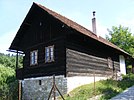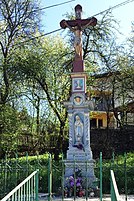|
Divinka
Divinka (Hungarian: Kisdivény) is a village and municipality in Žilina District in the Žilina Region of northern Slovakia. HistoryThe modern village of Divinka consists of two parts, which were originally two separate villages: Divinka (former Malá Divina) and Lalinok, which merged in 1911. During the Austro-Hungarian period, the village was a part of Trencsén County and belonged to the district of Kysucké Nové Mesto. The Veľký Vrch hill was fortified with ramparts of a vast hillfort, that rise up majestically above the village Divinka, which, thanks to its strategic location, has been inhabited since ancient times. This place, which gave many important testimonies of settlement in the times long before the first written mention of Divinka or Lalinok, is today a well-known cultural, historical and natural site. The castle occupies an area of approximately 12 hectares. Pieces of ceramics, iron, bronze and gold objects have been found there. The most famous discovery is the Celtic cointype "Divinka". The first written mention of Lalinok dates back to April 4, 1325, in the document dealing with the property transfers of the noble Borčický family, Lalinok is referred to as Lylihng. The earliest direct written record of Divinka is preserved in the letter of the Nitra Cathedral chapter (Latin: Capitulum Ecclesiae Nitriensis), dated to March 19, 1393. The Chapter announced not only King Sigismund of Luxembourg but all the villages of the Lietava estate, including Divinka (referred to as Kysdywyne) and Lalinok (referred to as Lelenk), too, that the new lawful overlord of Lietava castle and the estate had become Dezider from Kapla.[citation needed] Local residents have retained traditional folk costumes as well as dialect, but they are no longer worn. In the middle of the 19th century, divinity and tinker trade were the two most widespread crafts. A typical feature of this region was emigration. Local people traveled to the United States, Belgium, Denmark, and Germany to work there.[citation needed] GeographyThe municipality lies at an altitude of 327 metres and covers an area of 5.174 km². It has a population of about 1 024 people. Divinka is surrounded by a number of hills: Malý vrch, Veľký vrch, Prašivá, Všivák and Bok. Lalinok is surrounded by Homola and Hradisko. The highest point in the land area is the peak of Prašivá, with an altitude of 626 m above sea level. ReligionThe village has a strong Roman Catholic tradition. From the point of view of church autonomy, Divinka and Lalinok have never formed a separate parish. They have always been in the administration of other parishes since their creation. The municipalities alternately belonged to the Parish district Dolný Hričov or Kysucké Nové Mesto. After the establishment of a separate parish in the nearby village called Divina (former Veľká Divina) in 1771, Divinka and Lalinok joined it. Today, the village belongs to the administration of the Diocese of Žilina.[citation needed] An integral part of the history and demography of Divinka and Lalinok was also the Jewish ethnicity. The Jews moved to Divinka and Lalinok sometime in the first half of the 19th century and devoted themselves to timber trade and tavern services. The Jews left voluntarily later in 1918, after selling out their possessions to local residents.[citation needed] MonumentsDivinka
Lalinok
In Lalinok, old wooden folk houses from the 19th century have been preserved. A single track railway, which does not exist anymore, was the curiosity of Lalinok. It was used to transport material from the stone quarry in Divinka to construct the county road from Budatín to Kotešová. In the past, there were two mills in Divinka, one of which is now used as the Municipal office building.
Genealogical resourcesThe records for genealogical research are available at the state archive "Štátny archív v Žiline so sídlom v Bytči".
SportSki jumping is the most popular among sporting activities, locally. The origin of the skiing sport in Lalinok can be dated to 1940. Legendary were also the biking races that arose in 1991 and had a long tradition in the village. Like everywhere in the surrounding villages, Divinka and Lalinok have their own football history. At first football was played on natural playing fields with handball balls while the cattle grazed. Since 1939, Easter football tournaments have been played in nearby Svederník. Today there is a large football field in Divinka. Significant natives
See alsoReferences
External links |
||||||||||||||||||||||||||||||||||||||
Portal di Ensiklopedia Dunia












